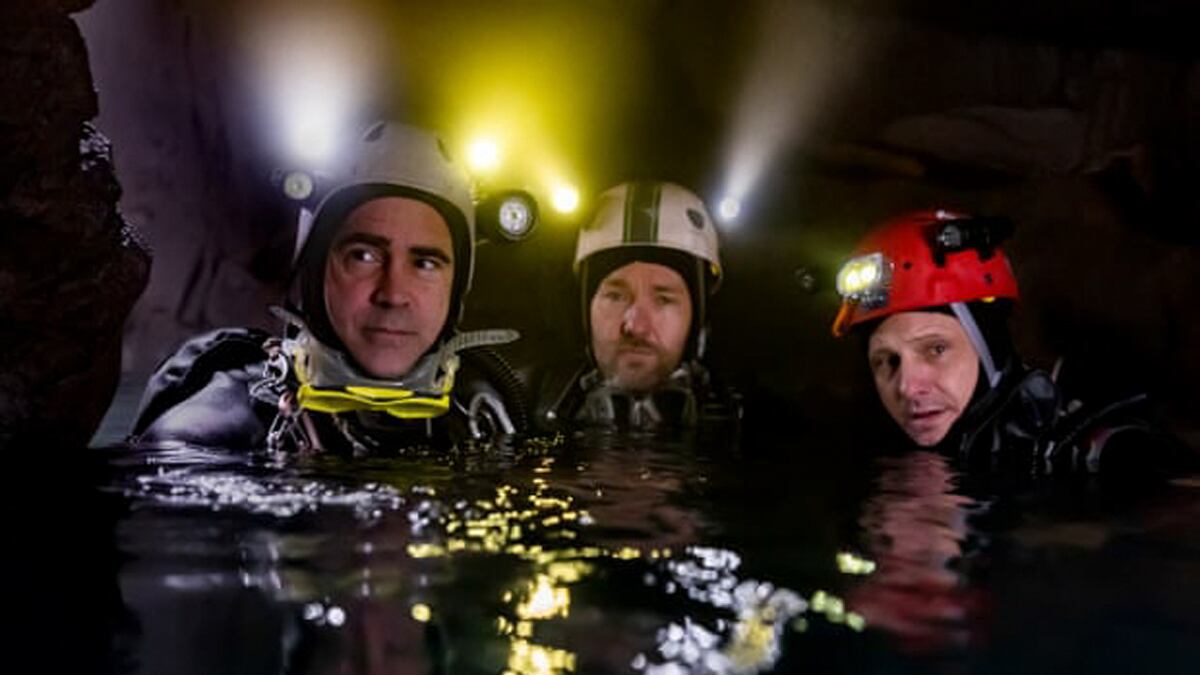THIRTEEN LIVES
**** On a sunny afternoon, 12 junior soccer players (and their coach) decide to explore a cave. As they enter, their crimson uniforms contrasting with the dark rocks, the boys have no idea that the cave will flood and that they will be trapped inside for 18 days—or that an international effort of more than 10,000 rescuers will be necessary to save them. Thirteen Lives tells that story, transforming the 2018 Tham Luang cave rescue in Thailand into a suspenseful, compassionate and disciplined film. It’s directed by Ron Howard, but without the soapy sensationalism of his most famous rescue movie, Apollo 13. As he observes the countless souls called to the cave—from parents desperate for news of their sons to volunteers who divert lethal amounts of water from the sinkholes above—it’s clear that he doesn’t care who these people were before the crisis or who they will be after. He simply wants us to be in the moment with them, feeling their terror and their dedication. Why? Because although Thirteen Lives celebrates the heroes of the rescue (including the British divers, played by Viggo Mortensen and Colin Farrell, who find the soccer team first), it isn’t about individuals. Howard wants to immerse us in a massive movement that, in some ways, transcended borders—”a war with water” that gave way to a vision of peace. PG-13. BENNETT CAMPBELL FERGUSON. Amazon Prime.
SAM NOW
**** This hard-earned family journalism project by Portland documentarian Reed Harkness sounds a bit like Boyhood or Michael Apted’s Up series at first blush. In the film, Harkness lovingly traces the childhood evolution of Sam, his 7-years-younger half-brother, who gleefully performs stunts and gags in front of a Super 8 camera. But fairly quickly, a mystery takes over Sam Now. In 2000, Sam’s mom vanishes; three years later, the Harkness boys turn their amateur filmmaking into a documented quest to find her. That’s plenty intriguing, but Sam Now soon transcends the search premise too. Like its subject and its director, it grows up, depicting the fractured Harkness family for what it is: a confluence of histories and pathologies that perhaps can’t be reconciled. Sam Now affords screen time and consideration to everyone in the family, and it’s a masterful editing achievement to stitch an 80-minute family portrait from material that could so easily be precious, overlong and myopic. Instead, the film balances the constant allure of the past with the irresolvable present. “Healing” is too linear a word. The most a family can do is try—and making a 25-year monument to understanding is one hell of an act of trying. NR. CHANCE SOLEM-PFEIFER. PAM CUT, Aug. 5.
PREY
*** It’s tempting to call Prey a “back to basics” entry in the Predator franchise, but it’s more of a prodigal return to a theme only implied in the steroidal, beautifully plot-light 1987 original starring Arnold Schwarzenegger. In that film, Arnold had to strip away technological vanity and embrace natural cunning with the help of Native American tracker Billy (Sonny Landham), the only one who could sense the intergalactic big-game hunter known as the Predator. In turn, Prey, directed by Dan Trachtenberg (10 Cloverfield Lane), pits the Predator against Comanche warriors in 1719. An overly cautious start classically establishes Naru (Amber Midthunder) as an anxious young woman dead set on hunting with the tribe’s men, and the film too bluntly emphasizes that the Predator is among them on the Great Plains. But once the green blood starts spilling, Prey is all animal rumbles, tomahawk training, exceedingly clever weapons choreography, and muscular outdoor cinematography by Jeff Cutter. It’s disappointing that the film won’t be released in theaters (blame Shane Black’s disastrous 2018 sequel The Predator). But at least at home, you can holler aloud at the spectacular violence as Naru proves her gravitas and the series is rescued by filmmakers who have discerned its decades of latent potential. R. CHANCE SOLEM-PFEIFER. Hulu.
FIRE OF LOVE
*** An essayistic portrait of volcanologist power couple Katia and Maurice Krafft, Fire of Love doesn’t overexert itself to make them camera ready. Pioneering and aestheticizing their field until their deaths in a volcanic explosion in 1991, they were always inadvertently preparing to be the subjects of director Sara Dosa’s stylish, adoring testament to the Kraffts’ two shared loves: volcanoes and each other. (By the way, Wes Anderson probably owes their estate a royalty for the red beanies and direct-to-face zooms we see in their mountains of documentary footage.) Narrated by the poetic murmurs by Miranda July and featuring a soundtrack that includes Ennio Morricone, Brian Eno and others, the film is head over heels for the “alchemy” of the Kraffts’ love and all that volcanoes symbolize in parallel: death, rebirth and unbridled, mysterious emotion. Eventually, Fire of Love runs dry of things to say about a couple who appears to have had no existence beyond studying and filming gorgeous hellfire, but it’s a film begging for big-screen beholding. The Kraffts spent their lives impossibly close to volcanoes, and in the film, they’re often seen as silhouettes dwarfed by nature at its most overpowering. Get small with them. PG. CHANCE SOLEM-PFEIFER. Bridgeport, City Center, Hollywood, Living Room.

